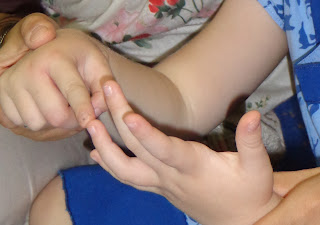Big books are a rich resource that can be used to
explicitly teach structured word inquiry. It is a very effective way to demonstrate the connection between the reading and writing systems.
Big books can be used to teach many different essential concepts about how the English language works.
In this post, I specifically want to focus on how to
embed structured word inquiry through reading, using big books (fiction/non fiction) as the starting point.
Selecting the most appropriate text for your students is an important planning step. I have chosen Mrs Wishy Washy, as this text is particularly rich in language with vocabulary that is interesting, predictable and repetitive for young children.
 |
| Dialogue is an important concept that is consistently modelled throughout this particular text. The word <said> is evident on most pages. |
I chose this word because it is often frequently seen in text; often used by young children for writing; and its orthographic structure demonstrates a very important understanding about how the English spelling system works.
To introduce the book to the children, after the initial readings I begin to focus on one or two elements. I would explicitly discuss the word <said> with the children, focusing on the MEANING of the word. In addition, I would also deliberately use this word when conducting a modelled writing session.
 |
| The word <said> has been 'covered' with card on some pages, as well as some other predictable words (animal names). |
The next reading session requires more active student involvement and participation. Predictable words, including <said>, are covered with post it notes and the students' task is to predict the covered words as we read along together. This ensures that MEANING and making sense of the text continues to be the focus.
In addition, during this initial investigation and introduction, the children are playing a word detective game, by searching for <said> on other pages and in other texts.
Investigating one of the puzzle pieces!
Just like a puzzle piece, you can now specifically focus on the word <said> and begin an orthographic investigation with the students.
Investigative questions, depending on the children's age and development, could possibly be: Why is <said> spelled with <ai>? Why is <said> spelled the way it is? How can we investigate the spelling of <said>?
Some ways to guide children's thinking, theories and learning:
1. Discover the word family and create the word web for the base <say> to demonstrate the connection with <said> .
(Please refer to the blog post: Can you teach morphology to young children? for some suggested word web activities particularly with young children.)
2. Investigate, to understand, the structure of the word, by creating the morphological word sum. By investigating the now non productive suffix
<-d>, it leads to further understanding of other words in English.
say/i + d --> said
3. Discover the etymology of <say> and <said>, to demonstrate the meaning connection and the fascinating historical 'story'!
4. Students individually write and 'spell out' the word sum on whiteboards (or with pen/paper) to fix the spelling in long term memory.
 |
| Investigating the meaning of words is like "opening up a mystery box", demonstrates that spelling has many layers to be discovered! |
The word <said> clearly demonstrates how English spelling is first and foremost based on meaning and it is only through investigating its meaning that we can begin to understand the spelling...
just like so many other words we encounter!
Investigating <said> is just one example of how you can guide a structured word inquiry, through big books. There are many other significant words that young children encounter in their early reading experiences. Often they are called 'high frequency words' and children have the right to know and fully understand the spelling.
 |
| Investigating the orthography of <was> leads to a deep understanding of many other words.  |
There are rich orthographic 'stories' underlying:
<one> <was> <his> <two> <they>



































.JPG)